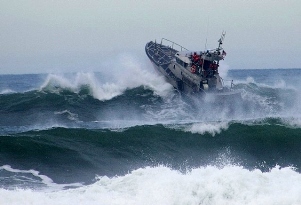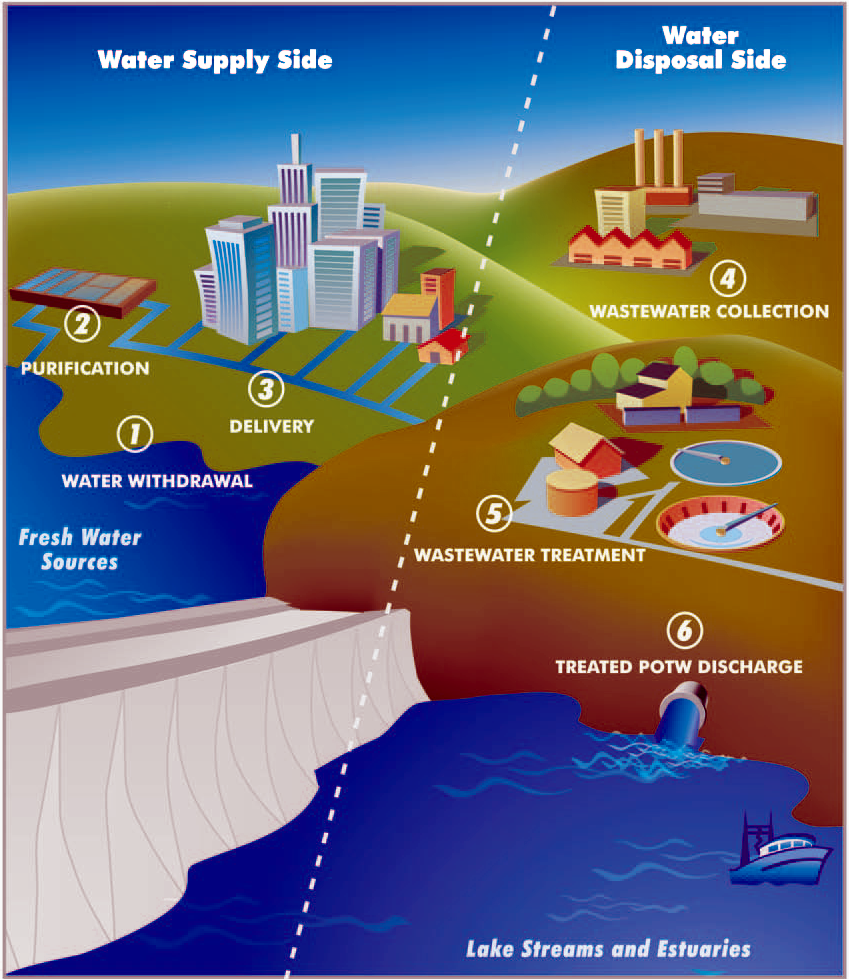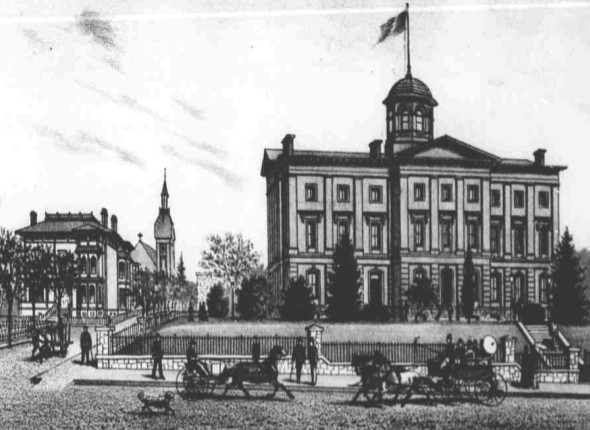|
Bayocean
Bayocean was a community in Tillamook County, Oregon, United States. Sometimes known as "the town that fell into the sea", it was a planned resort community founded in 1906 on Tillamook Spit, a small stretch of land that forms one wall of Tillamook Bay. Bayocean's post office was established on February 4, 1909, and by 1914, the town's population was 2,000. Only a few decades later however, Bayocean had become a ghost town, having had many of its attractions destroyed by "man-induced" coastal erosion. The town's unforeseen destruction is believed by many to have been caused by the residents themselves. Development The location of Bayocean was said to have been discovered by co-founder Thomas Irving Potter while sight-seeing and hunting along the Oregon Coast. It was called by both T. I. Potter and his father/business partner Thomas Benton Potter, who envisioned the venture as the " Atlantic City of the West". Believing the site to have an exceptional view of both Tillamook ... [...More Info...] [...Related Items...] OR: [Wikipedia] [Google] [Baidu] |
Bayocean Oregon 2022
Bayocean was a community in Tillamook County, Oregon, United States. Sometimes known as "the town that fell into the sea", it was a planned resort community founded in 1906 on Tillamook Spit, a small stretch of land that forms one wall of Tillamook Bay. Bayocean's post office was established on February 4, 1909, and by 1914, the town's population was 2,000. Only a few decades later however, Bayocean had become a ghost town, having had many of its attractions destroyed by "man-induced" coastal erosion. The town's unforeseen destruction is believed by many to have been caused by the residents themselves. Development The location of Bayocean was said to have been discovered by co-founder Thomas Irving Potter while sight-seeing and hunting along the Oregon Coast. It was called by both T. I. Potter and his father/business partner Thomas Benton Potter, who envisioned the venture as the " Atlantic City of the West". Believing the site to have an exceptional view of both Tillamook ... [...More Info...] [...Related Items...] OR: [Wikipedia] [Google] [Baidu] |
Tillamook Bay
Tillamook Bay is a small inlet of the Pacific Ocean, approximately 6 mi (10 km) long and 2 mi (3 km) wide, on the northwest coast of the U.S. state of Oregon. It is located just north of Cape Meares in western Tillamook County approximately 75 mi (120 km) west of Portland. Description and history The bay is protected from the open ocean by shoals and a 3 mi (5 km) sandbar called the Bayocean Peninsula. It is surrounded closely by the Coastal Range except at its southeast end, where the town of Tillamook sits near the mouths of the Kilchis, Wilson, Trask and Tillamook rivers, which flow quickly down from the surrounding timber-producing regions of the Coastal Range to converge at the bay. The short Miami River enters the north end of the bay. The small fishing village of Garibaldi sits near the cliffs opening of the bay in the ocean. The rivers that feed the bay are known for their prolific steelhead and salmon runs. The mixing ... [...More Info...] [...Related Items...] OR: [Wikipedia] [Google] [Baidu] |
Steamboats Of The Oregon Coast
The history of steamboats on the Oregon Coast begins in the late 19th century. Before the development of modern road and rail networks, transportation on the coast of Oregon was largely water-borne. This article focuses on inland steamboats and similar craft operating in, from south to north on the coast: Rogue River, Coquille River, Coos Bay, Umpqua River, Siuslaw Bay, Yaquina Bay, Siletz River, and Tillamook Bay. The boats were all very small, nothing like the big sternwheelers and propeller boats that ran on the Columbia River or Puget Sound. There were many of them, however, and they came to be known as the "mosquito fleet." Routes and operations Rogue River The Rogue River meets the Pacific Ocean at Gold Beach, and flows all the way from the Cascade Mountains. R. D. Hume was a pioneering businessman at Wedderburn and Gold Beach, then known as Ellensburg. By 1881, he had established a fish cannery and built a steam schooner, '' Mary D. Hume'', to support the cannery oper ... [...More Info...] [...Related Items...] OR: [Wikipedia] [Google] [Baidu] |
Tillamook County, Oregon
Tillamook County is one of the 36 counties in the U.S. state of Oregon. As of the 2020 census, the population was 27,390. The county seat is Tillamook. The county is named for the Tillamook or Killamook people, a Native American tribe who were living in the area in the early 19th century at the time of European American settlement. The county is located within Northwest Oregon. The Tillamook were the southernmost branch of the Coast Salish. They were separated from their more northern kinsmen by tribes speaking the Chinookian languages. The name Tillamook is of Chinook origin (a trade pidgin, which had developed along the lower Columbia.) According to Frank Boas, "It illamookmeans the people of Nekelim. The latter name means the place of Elim, or in the Cathlamet dialect, the place of Kelim. The initial t of Tillamook is the plural article, the terminal ook the Chinook plural ending —uks." Since there was one village in the area of Nehalem bay; the area was referred ... [...More Info...] [...Related Items...] OR: [Wikipedia] [Google] [Baidu] |
Oregon Coast
The Oregon Coast is a coastal region of the U.S. state of Oregon. It is bordered by the Pacific Ocean to its west and the Oregon Coast Range to the east, and stretches approximately from the California state border in the south to the Columbia River in the north. The region is not a specific geological, environmental, or political entity, and includes the Columbia River Estuary. The Oregon Beach Bill of 1967 allows free beach access to everyone. In return for a pedestrian easement and relief from construction, the bill eliminates property taxes on private beach land and allows its owners to retain certain beach land rights. Traditionally, the Oregon Coast is regarded as three distinct sub–regions: * The North Coast, which stretches from the Columbia River to Cascade Head, Oregon, Cascade Head. * The Central Coast, which stretches from Cascade Head to Reedsport, Oregon, Reedsport. * The South Coast, which stretches from Reedsport to the U.S. Route 101 in Oregon#Brookings to C ... [...More Info...] [...Related Items...] OR: [Wikipedia] [Google] [Baidu] |
Gas Station
A filling station, also known as a gas station () or petrol station (), is a facility that sells fuel and engine lubricants for motor vehicles. The most common fuels sold in the 2010s were gasoline (or petrol) and diesel fuel. Gasoline pumps are used to pump gasoline, diesel, compressed natural gas, CGH2, HCNG, Liquefied petroleum gas, LPG, liquid hydrogen, kerosene, alcohol fuel (like methanol, ethanol, butanol, propanol), biofuels (like straight vegetable oil, biodiesel), or other types of fuel into the tanks within vehicles and calculate the financial cost of the fuel transferred to the vehicle. Besides gasoline pumps, one other significant device which is also found in filling stations and can refuel certain (compressed-air) vehicles is an air compressor, although generally these are just used to inflate car tires. Many filling stations provide convenience stores, which may sell confections, alcoholic beverages, tobacco products, lottery tickets, soft drinks, s ... [...More Info...] [...Related Items...] OR: [Wikipedia] [Google] [Baidu] |
Infrastructure
Infrastructure is the set of facilities and systems that serve a country, city, or other area, and encompasses the services and facilities necessary for its economy, households and firms to function. Infrastructure is composed of public and private physical structures such as roads, railways, bridges, tunnels, water supply, sewerage, sewers, electrical grids, and telecommunications (including Internet access, Internet connectivity and Broadband, broadband access). In general, infrastructure has been defined as "the physical components of interrelated systems providing Commodity, commodities and services essential to enable, sustain, or enhance societal quality of life, living conditions" and maintain the surrounding environment. Especially in light of the massive societal transformations needed to Climate change mitigation, mitigate and Climate change adaptation, adapt to climate change, contemporary infrastructure conversations frequently focus on sustainable development and gre ... [...More Info...] [...Related Items...] OR: [Wikipedia] [Google] [Baidu] |
Water System
A water supply network or water supply system is a system of engineered hydrologic and hydraulic components that provide water supply. A water supply system typically includes the following: # A drainage basin (see water purification – sources of drinking water) # A raw water collection point (above or below ground) where the water accumulates, such as a lake, a river, or groundwater from an underground aquifer. Raw water may be transferred using uncovered ground-level aqueducts, covered tunnels, or underground water pipes to water purification facilities. # Water purification facilities. Treated water is transferred using water pipes (usually underground). # Water storage facilities such as reservoirs, water tanks, or water towers. Smaller water systems may store the water in cisterns or pressure vessels. Tall buildings may also need to store water locally in pressure vessels in order for the water to reach the upper floors. # Additional water pressurizing components such ... [...More Info...] [...Related Items...] OR: [Wikipedia] [Google] [Baidu] |
Diesel Fuel
Diesel fuel , also called diesel oil, is any liquid fuel specifically designed for use in a diesel engine, a type of internal combustion engine in which fuel ignition takes place without a spark as a result of compression of the inlet air and then injection of fuel. Therefore, diesel fuel needs good compression ignition characteristics. The most common type of diesel fuel is a specific fractional distillate of petroleum fuel oil, but alternatives that are not derived from petroleum, such as biodiesel, biomass to liquid (BTL) or gas to liquid (GTL) diesel are increasingly being developed and adopted. To distinguish these types, petroleum-derived diesel is sometimes called petrodiesel in some academic circles. In many countries, diesel fuel is standardised. For example, in the European Union, the standard for diesel fuel is EN 590. Diesel fuel has many colloquial names; most commonly, it is simply referred to as ''diesel''. In the United Kingdom, diesel fuel for on-road us ... [...More Info...] [...Related Items...] OR: [Wikipedia] [Google] [Baidu] |
Portland, Oregon
Portland (, ) is a port city in the Pacific Northwest and the largest city in the U.S. state of Oregon. Situated at the confluence of the Willamette and Columbia rivers, Portland is the county seat of Multnomah County, the most populous county in Oregon. Portland had a population of 652,503, making it the 26th-most populated city in the United States, the sixth-most populous on the West Coast, and the second-most populous in the Pacific Northwest, after Seattle. Approximately 2.5 million people live in the Portland metropolitan statistical area (MSA), making it the 25th most populous in the United States. About half of Oregon's population resides within the Portland metropolitan area. Named after Portland, Maine, the Oregon settlement began to be populated in the 1840s, near the end of the Oregon Trail. Its water access provided convenient transportation of goods, and the timber industry was a major force in the city's early economy. At the turn of the 20th centu ... [...More Info...] [...Related Items...] OR: [Wikipedia] [Google] [Baidu] |
Power Plant
A power station, also referred to as a power plant and sometimes generating station or generating plant, is an industrial facility for the generation of electric power. Power stations are generally connected to an electrical grid. Many power stations contain one or more generators, a rotating machine that converts mechanical power into three-phase electric power. The relative motion between a magnetic field and a conductor creates an electric current. The energy source harnessed to turn the generator varies widely. Most power stations in the world burn fossil fuels such as coal, oil, and natural gas to generate electricity. Low-carbon power sources include nuclear power, and an increasing use of renewables such as solar, wind, geothermal, and hydroelectric. History In early 1871 Belgian inventor Zénobe Gramme invented a generator powerful enough to produce power on a commercial scale for industry. In 1878, a hydroelectric power station was designed and bui ... [...More Info...] [...Related Items...] OR: [Wikipedia] [Google] [Baidu] |








